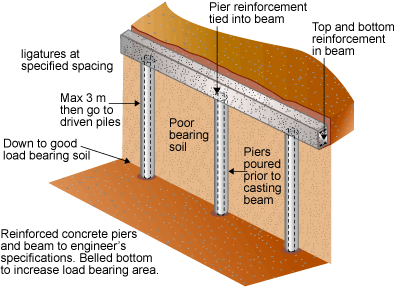Bored pier and beam systems
The primary difference between the bulk pier and beam and the bored pier and beam is the size of the piers. The bored piers are much smaller than the bulk piers. They are similar in slenderness to free standing, above ground concrete columns. The diameter of the piers is usually 450 mm or 600 mm.
A machine similar to a posthole digger drills out the pier holes. The drilling rig can also penetrate to depths of three metres without any effort or problem in free standing soil. There is minimal disturbance to adjoining structures. A minimum of four vertical reinforcement bars are placed in the column with R6 ligatures at 300 mm centres.
Lateral pressures in the soil can have adverse effects on the pier. Steel reinforcement may be required to resist sideways forces created by soil thrust or earth tremors/quakes.
The bases of the piers are founded on good bearing soil at the appropriate depth. If the bearing capacity of the soil is low, the base of the pier can be increased. This is to give adequate support to the structure and spread the forces over a greater bearing area. This method of increasing the base is often called 'belling' the piers. With belling there is no need to increase the total diameter of the pier, which is uneconomical and is unnecessary to achieve a greater base bearing area.

